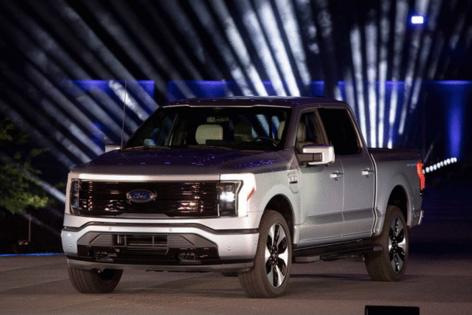Tax break for electric vehicles is ending. How does that impact drivers?
Published in News & Features
The tax break of up to $7,500 on new or leased electric vehicles, as well as the $4,000 credit for used EVs, will be gone after Sept. 30.
To clean energy advocates around the country, that means consumers will pay more and the environment will suffer.
The credit for used EVs in particular is a “lost opportunity to reduce transportation energy burden and help ... families save thousands of dollars in fuel costs,” said Ingrid Malmgren, senior policy director at Plug In America, an education and advocacy nonprofit.
Conservatives have been eager to do away with the credit, saying it was little more than a subsidy for consumers who had no need for it.
“The hard-earned money of taxpaying Americans should not cover the cost for the luxuries of the nation’s elite,” said Senate Majority Whip John Barrasso, R-Wyoming.
The credits were enacted in 2022 as part of President Joe Biden’s Inflation Reduction Act.
The credits can help qualified buyers or lessees of electric vehicles, hybrid plug-in or fuel-cell-powered cars with a manufacturer’s suggested retail prices of $55,000 or less or vans, SUVs or trucks with an MSRP of $80,000 or less. The vehicle’s final assembly must be in North America.
Income limits on current tax breaks
The breaks are available on new vehicles to joint income tax filers with modified adjusted gross income under $300,000 and individuals with modified AGI under $150,000. The income limits to qualify for breaks on used vehicles are lower.
The bill had no Republican support, and many GOP lawmakers vowed to repeal it as soon as they could. They did just that in the Big Beautiful Bill, a sweeping tax and spending measure President Donald Trump signed into law on July 4.
The repeal had strong backing from influential conservative groups such as Americans for Prosperity.
“The Biden-era EV credits were a top-down policy that picked winners and losers, distorted markets and put upward pressure on consumer prices,” Faith Burns, the group’s energy policy fellow, told The Bee.
The Big Beautiful Bill, she said, “prioritizes unleashing American energy independence by reducing government overreach like these Biden-era credits for the wealthy.”
But Malmgren saw the repeal as putting pressure on local governments.
“The repeal of the federal Clean Vehicle Tax Credits will increase the reliance on state and utility incentives to help consumers buy cleaner vehicles. This will particularly burden lower-income drivers and families since the federal incentives have been so successful at making electric vehicle purchase prices more affordable,” she said.
Weeks after Trump was elected, California Gov. Gavin Newsom pledged to restart a statewide clean car rebate program if the new president yanked federal subsidies. Until 2023, the state offered up to $7,500 to purchase or lease electric, fuel cell and plug-in hybrid vehicles.
But the governor has not laid out any specific plans and just signed a budget that closed a $12 billion deficit with no new money for EV incentives.
When asked for comment, Newsom’s office signaled that any new rebates would be tied to the governor’s push to reauthorize cap-and-trade, the program that sells emissions credits and reinvests the funds in climate projects.
“Pending these discussions, this could include new zero-emission vehicle incentives,” said Daniel Villaseñor, Newsom’s deputy communications director.
Sen. Ben Allen, D-Santa Monica, is skeptical. “The challenge is that the cap-and-trade fund has been massively raided already,” said Allen, who chairs the Senate’s budget subcommittee on environmental spending. He pointed out Newsom shifted about $1 billion for Cal Fire funding from the General Fund to the Greenhouse Gas Reduction Fund this year and wants to commit another $1 billion annually for high-speed rail.
“I’m very disappointed by the president’s decision” to end EV credits, Allen said. “I appreciated the governor’s initial reaction. At the same time, I’m also very cognizant of how limited resources are.”
During its 13-year lifespan, California’s clean car rebate program doled out nearly $1.5 billion in incentives, which helped residents buy more than 594,000 vehicles, according to state figures.
The rebate shut down two years ago as the state began prioritizing assistance for low-income households to purchase EVs.
The end of EV credits will “impact the market some,” said energy lobbyist Frank Maisano, but maybe less so in California, where EVs have had a higher uptake than in other states.
“We are almost beyond the early adopters, especially in California, so incentives can be helpful to get new first-time EV owners, but it is still a struggle to get them in EVs because some people just don’t like the inconveniences that come with EVs,” he said.
The cost of a car
AAA has found that a new, compact EV costs about $600 more overall than a similar gasoline-powered car. It said the electricity needed to drive 15,000 miles annually in a compact EV costs an average of $546. A gasoline-powered car driven a similar distance would cost $1,255.
First looking at cost by using the same methodology as its annual Your Driving Costs study, AAA found that owning a new, compact electric vehicle was only slightly more expensive – about $600 annually – than its gas-powered counterpart. Although the overall costs are more, electric vehicles are lower in individual categories such as fuel and maintenance.
AAA found that because EVs don’t need as much maintenance – they don’t need oil changes, for instance – the cost for upkeep would be $330 less than the $949 annually a gasoline-powered car costs.
_____
©2025 McClatchy Washington Bureau. Visit at mcclatchydc.com. Distributed by Tribune Content Agency, LLC.







Comments